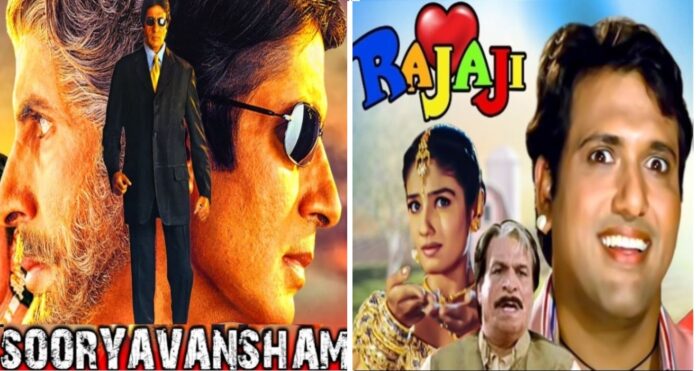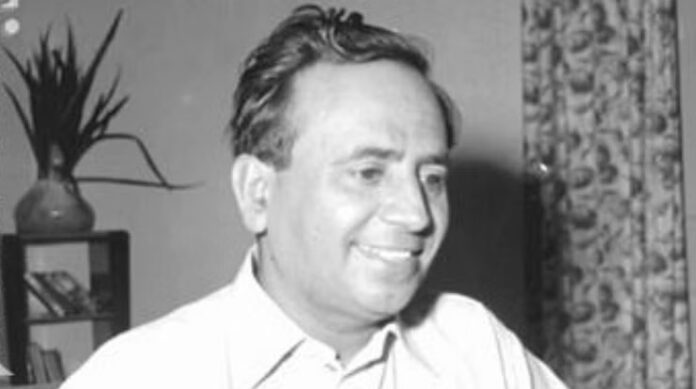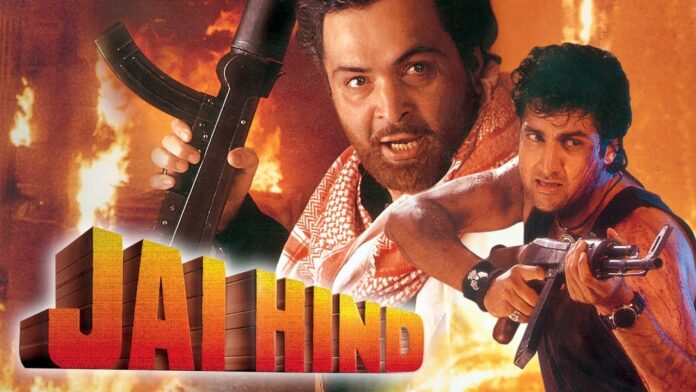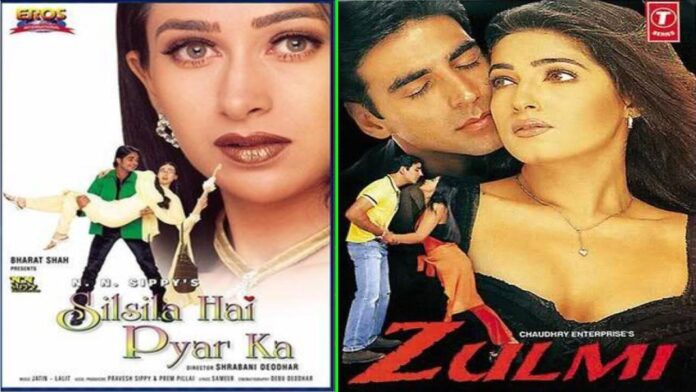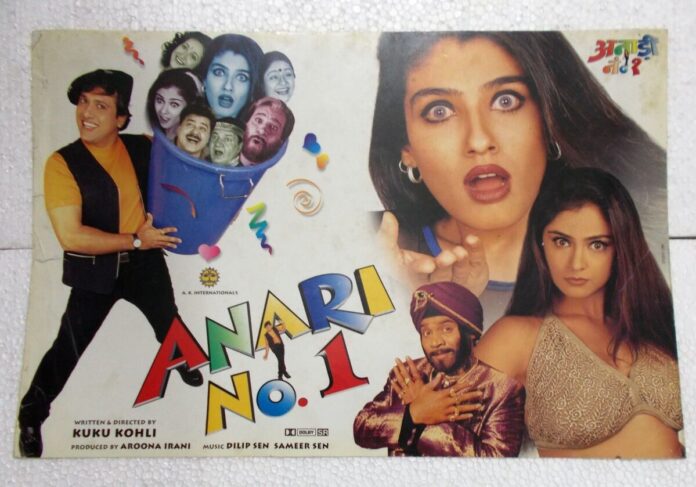BIWI NO. 1
Puja Films’ Biwi No. 1 (UA) is the story of a young, married and successful businessman who has an affair with a model working for his company. When his wife comes to know of his affair, she confronts him and gives him two options to choose from — either forget the affair and the model forever or leave the house. The husband, agitated at being questioned by his wife, opts for the latter and starts living with his model girlfriend. Although not married to her, he lives with her as would a husband and wife. When this happens, the wife and a family friend join hands to teach the errant husband and his girlfriend a terrible lesson. For this, the wife herself becomes a model and even sends her two kids and mother-in-law to live with her husband and his girlfriend. The kids and the ma-in-law, under instructions from the wife, create situations to show the girlfriend in such bad light always that the husband starts hating his girlfriend. Finally, the husband and wife re-unite. The model returns to the photographer who had proposed marriage to her earlier.
Inspired from the Tamil film Sathi Leelavathi, the film is an out-and-out comedy. The first half is just about fair. It is the second half which is more entertaining, and the two climaxes (one involving all the main characters, and the other with Anil Kapoor, Tabu and their child) are truly hilarious. But the drama is weak and has some drawbacks. The wife is shown to be so rich, modern and beautiful that her pining for her husband (even after knowing that he is sleeping around with the model) appears rather unbelievable. Had the wife been shown to be ordinary-looking and also financially insecure, the pining would’ve looked more plausible. Further, the serious point of the husband straying has been treated too lightly. Showing the wife turning a model herself is unnecessary because after she does take up modelling, there’s no more reference to her new profession. Dialogues (Rumi Jafri) have punch at places but fall flat at some places in the first half. Emotions post-interval are feeble. Some adult jokes are quite funny.
Salman Khan does well as the husband gone wayward. He is especially good in comedy scenes and dances. Karisma Kapoor plays Salman’s wife to perfection. She shines in emotional scenes. Anil Kapoor, as the Punjabi doctor-friend of Salman Khan, is extremely likeable. Tabu plays Anil’s wife very ably. The climax on Anil and Tabu is fantastic. These two Punjabi characters will hold special appeal for audience in Punjab and Delhi. Sushmita Sen acts like a seasoned actress and is admirably free in her performance. Looking sexy and fashionable, she plays the model brilliantly. Saif Ali Khan is alright. Himani Shivpuri and Shashi Kiran lend wonderful support as Salman’s mother and secretary respectively. Master Rinku and baby Pinky are cute. The dog does an able job. Guddi Maruti, Rajiv Verma and Kanu Gill are okay.
David Dhawan seems to be in form after interval. At several places in the film, though, it does appear that David has made the film as a rush job. Music (Anu Malik) is good. The title song, ‘Sona sona’, ‘Jungle mein’ and ‘Mehboob mere’ numbers are racy and well-tuned. ‘Om Sai Ram’ song is designed to appeal emotionally. Song picturisations (Ganesh and B.H. Tharun Kumar) are excellent. Special mention in this regard must be made of the ‘Sona sona’ number, the title song, and ‘Mehboob mere’ songs. Foreign locations are heavenly. K.S. Prakash Rao’s camerawork is good. Production values are simply grand. Background score (Surender Sodhi) is effective. Editing is sharp. Sets are rich. Other technical values are of a good standard.
On the whole, Biwi No. 1 has taken a flying start and it does have comic masala to make people laugh and its distributors smile.
Released on 28-5-’99 at Metro and 19 other cinemas of Bombay by Puja Films thru Shringar Films. Publicity & opening: simply breathtaking. …….Also released all over. Opening was bumper in Delhi (1st day almost 100%) and East Punjab and very good elsewhere. (1st day Jaipur 2,80,138/- from 5 cinemas.)
LATEST POSITION
The box-office took a severe beating on Wednesday (26th May) due to the India-Sri Lanka cricket match.
Sooryavansham proves a total loss. It has recorded extremely poor collections as it failed to pick up after a dismal start, despite appreciation. It, however, picked up in Calcutta and, to some extent, in Bihar. 1st week Bombay 28,32,459 (45.81%) from 11 cinemas (8 on F.H.); Ahmedabad 9,88,714 from 6 cinemas, Baroda 96,948, Padra 88,314, Rajkot 94,633, Jamnagar 60,966; Pune 7,58,063 from 5 cinemas, Kolhapur 1,25,000, Solapur 2,63,725 from 2 cinemas; Delhi 18,46,238 (28.43%) from 13 cinemas; Kanpur 91,577, Lucknow 2,40,591, Agra 1,69,756, Varanasi 1,03,783, Bareilly 64,403 (23.44%), Dehradun 83,282; Calcutta 29,76,819 from 27 cinemas; Nagpur 3,03,777 from 3 cinemas, Jabalpur 58,687, Amravati 1,13,879, Akola 1,07,470, Raipur 1,04,049, Bhilai 80,130; Bhopal 1,45,416 from 2 cinemas; Jaipur 3,35,862 from 3 cinemas; Hyderabad (gross) 21,26,662 from 9 cinemas, share (including Aurangabad, Parbhani and Warangal) 13,20,541; Vijayawada (gross) 1,50,574, Guntur (gross, 6 days) 85,952, Ongole (gross, 6 days) 97,584.
Rajaji started dropping from 2nd day onwards. 1st week Bombay 30,86,127 (65.23%) from 11 cinemas (11 on F.H.); Ahmedabad 7,83,640 from 4 cinemas, Rajkot 1,14,595; Pune 5,76,794 from 4 cinemas (1 in matinee), Kolhapur 1,24,000, Solapur 2,08,517 from 3 cinemas (1 in matinee); Delhi 28,96,036 (51.91%) from 10 cinemas (1 on F.H.); Kanpur 2,93,457 from 2 cinemas, Lucknow 1,76,680, Agra 2,63,589, Bareilly 90,637 (65.33%); Calcutta 2,74,982 from 1 cinema (other cinemas’ collections undisclosed); Nagpur 3,87,122 from 4 cinemas, Jabalpur 83,350, Amravati 1,40,340, Akola 1,28,167, Raipur 1,48,581, Bhilai 83,462, Jalgaon 1,39,195; Indore 3,11,000 from 2 cinemas (2 on F.H.), Bhopal 2,26,438 from 2 cinemas; Jaipur 5,85,487 from 3 cinemas; Hyderabad (gross) 9,05,502 from 6 cinemas (1 in noon, 1 on F.H.).
Hogi Pyar Ki Jeet 3rd week Bombay 9,63,292 (45.76%) from 5 cinemas (6 on F.H.); Ahmedabad 2,36,259 from 3 cinemas, Rajkot (matinee) 18,492, Jamnagar 57,459; Pune 4,05,225 from 4 cinemas, Kolhapur 1,27,000, Solapur 97,187; Delhi 1,38,798 (1 on F.H.); Kanpur 2,35,430 from 2 cinemas, Lucknow 2,29,185, Agra 1,75,948, Varanasi 1,77,980, Bareilly 70,568 (23.28%), Dehradun 93,000 (2nd 1,10,000); Calcutta 8,85,711 from 6 cinemas; Nagpur 1,86,501 from 3 cinemas, Jabalpur 1,13,054, total 4,68,200, Amravati 1,62,738, Akola 1,01,166, total 3,73,886, Raipur 1,71,131, Bhilai 1,17,180, Jalgaon 1,00,389, Chandrapur 75,868, total 3,54,320; Jaipur 1,44,633, Bikaner 79,579; Hyderabad (gross) 5,76,785 from 3 cinemas (1 in noon).
Kartoos 3rd week Bombay 9,14,687 (37.97%) from 6 cinemas (7 on F.H.); Pune 99,102 from 2 cinemas (1 in matinee), Kolhapur 81,617, Solapur 46,676 from 2 cinemas (1 in matinee), 1st week Barsi 49,561; 3rd week Delhi 3,70,700 from 3 cinemas (1 on F.H.); Kanpur 1,45,056 from 2 cinemas, Bareilly 33,559 (15.01%), Dehradun 61,152 (2nd 1,01,003); Calcutta 1,29,879; Nagpur 70,785 from 2 cinemas, Jabalpur (6 days) 41,028, Amravati (6 days) 28,691, Raipur (6 days) 28,005, Bhopal 41,030; Jaipur 1,23,248, Bikaner 2,24,000; Hyderabad (gross) 2,69,884 from 2 cinemas; Vijayawada 3 weeks’ total (gross) 5,10,293, 1st week Guntur (gross) 97,588.
Sarfarosh 4th week Bombay 36,82,522 (81.41%) from 11 cinemas (5 on F.H.); Ahmedabad 1,47,598 (2 unrecd.); Pune 9,66,035 from 4 cinemas (1 in matinee), Kolhapur 1,37,570, Solapur 1,50,430, 1st week Miraj 1,09,000; 4th week Delhi 12,51,005 from 4 cinemas; Kanpur 2,01,712 from 2 cinemas, Lucknow 2,73,098, Agra 1,53,926, Varanasi 1,36,489, Bareilly 42,491 (14.97%), Dehradun 1,35,000 (3rd 1,64,153); Nagpur 1,49,273, 1st Jabalpur 2,39,173, 4th week Amravati 1,42,176, Akola 63,256, total 4,26,842, Raipur 56,396, Jalgaon 80,006, 3rd week Wardha (6 days) 43,431; 4th Indore 1,72,400 from 2 cinemas; Jaipur 6,22,657, Bikaner 20,481; Hyderabad (gross) 6,25,166 from 2 cinemas; Vijayawada 2 weeks’ total (gross) 4,55,085.
________
Dada Ne Wahalee Dikri (Gujarati; TF) 5th week Ahmedabad 3,10,046 from 3 cinemas, Baroda 42,500, 1st week Idar 1,05,009, 5th week Rajkot 1,04,000.
SALMAN KHAN CHARGESHEETED
Chargesheets were filed against Salman Khan and others in the court of additional civil judge and judicial magistrate P.K. Vashist of Jodhpur on 24th May for allegedly poaching protected black bucks near Jodhpur last year when he had gone there to shoot for Rajshri’s Hum Saath Saath Hain. The chargesheets have been filed under sections 147, 148, 149 and 201 of the Indian Penal Code and sections 9, 39, 51 and 52 of the Arms Act. The other accused in the chargesheets are local people, mostly related to the tourism trade.
CHOWK IN MEMORY OF LAXMIKANT
The spacious lawns at music director Laxmikant’s Juhu bungalow have been host to many a party on Diwali (Laxmi pooja) day. For, Laxmikant used to celebrate his birthday every Diwali day in style and with his film industry friends. Whisky used to flow freely at the party which used to go on till the wee hours of the following morning. Spirits used to be high at such parties which used to be largely attended.
The same lawns on 25th May this year were host to yet another film gathering. But instead of whisky, it was a sober water-melon juice that did the rounds. The spirits weren’t exactly high because the mood was sober. The occasion was the naming ceremony of a public square (chowk) outside Laxmikant’s bungalow in memory of the late music director.
Maharashtra chief minister Narayan Rane did the honours by unveiling the two plaques with the name of the square — Sangeetkar Laxmikant Chowk — and garlanding the plaques. Deputy chief minister Gopinath Munde was the chief guest while Hareshwar Patil (mayor of Bombay), Nitin Gadkari (public works department minister) and Datta Rane (minister for higher and technical education) were the guests of honour. Local municipal councillor Arun Deo presided over the function. Chief minister Narayan Rane promised to build a memorial of Laxmikant in Sindhudurg where the late music director was born.
Subhash Ghai and Javed Akhtar made speeches recalling the great works of Laxmikant. The ministers also spoke on the occasion. Among the other luminaries who attended the function were Manoj Kumar, Shabana Azmi, Randhir Kapoor, Rishi Kapoor, Surinder Kapoor, Boney Kapoor, Anil Kapoor, Sanjay Kapoor, Jackie Shroff, Asrani, Bindu (Laxmikant’s sister-in-law), Pyarelal, Suresh Wadkar, Kavita Krishnamoorthy, Shabbir Kumar, Shailendra Singh, Nalin Dave, Manhar Udhas, Bappi Lahiri, Aadesh Shrivastava, Ramesh Taurani and Dinesh Gandhi.
Tears welled up in the eyes of Laxmikant’s widow, Jaya, as Narayan Rane was unveiling the plaque. For, although the square-naming ceremony was a proud moment in her life, the cause for it was the saddest memory of her life.
AAMIR ON HIS HOME PRODUCTION, ‘LAGAAN’
KOMAL NAHTA
When it comes to sincerity, few can match Aamir Khan’s. For the dubbing of emotional scenes, the perfectionist star puts glycerine in his eyes and dubs the dialogues as the make-believe tears roll down his cheeks. All this, so that the voice conveys the emotions perfectly. At one such dubbing session, I met Aamir Khan as well as the glycerine bottle, placed on a table next to the chair the actor was occupying. Unfortunately though, Aamir had no use of the glycerine when I met him, since it wasn’t an emotional scene he was dubbing for. Although Mann is said to abound in tear-jerking scenes, it was a scene of fun ‘n’ frolic that Aamir was giving his voice to at Empire that evening.
The success of Sarfarosh was written all over Aamir’s face. There was no place for pride in his scheme of things, just simple joy. Yes, but he was definitely proud of debut-making director John Mathew Matthan. “The man needs credit for having made such a film — and succeeded,” remarked Aamir. For, although the film may not be a runaway hit outside Bombay and Maharashtra, it, nevertheless, is doing good business in all cities of all the circuits. In other words, no distributor stands to lose in the film. While it will give commission to its distributors of other circuits, some may even share overflow with John.
Besides Sarfarosh and Mann (about which also Aamir is extremely excited), Aamir’s home production also has the guy all charged up. Called Lagaan (Tax), the film, informed Aamir, is a period drama set in the year 1890 in a village in India. Yes, you’ve guessed it right — Aamir will wear a dhoti in the film, which will be a first in his career.
Lagaan is scripted and will be directed by Ashutosh Gowariker and, to quote Aamir, “I couldn’t believe it when I first heard the script, it’s so good.” The dialogues are being written by K.P. Saxena who Ashutosh re-discovered from do gaz zameen ke neeche. Not literally, but almost so. K.P. Saxena had penned the dialogues for Ramsays’ Do Gaz Zameen Ke Neechey although he couldn’t take credit for the same due to technical reasons. Lucknow-based Saxena also did ghost-writing for a film or two and is a well-known hasya kavi too.
Rani Mukerji was to have played Aamir’s heroine in Lagaan but a new heroine is now being finalised. “Date problems,” says Aamir, adding, “When we approached her for our film, she had already committed the dates we needed, to some other producers. She did try to adjust them for Lagaan but it was impossible for her. I, too, did not want her to cancel someone else’s dates for my film because, I wouldn’t have liked anyone doing that with dates allotted to me as a producer.”
Aamir is currently in Bhuj (Gujarat) to finalise locations for the film and is expected back in Bombay on 30th. He will fly to London on June 2 or 3 to finalise some British actors and actresses for his film. “Since the film is set in pre-Independence India, there are some British characters too in the film. Besides character artistes, one heroine will also be British,” explained the star.
Lagaan will be shot in one single schedule of four months beginning November 11. The entire shooting will be done in Bhuj. Aamir has already signed A.R. Rahman for the music score although the lyricist/s is/are yet to be finalised.
This is all I can get out of Aamir in the total of 20 minutes in between his dubbing takes. Before recordists Chaturvedi and Pradeep Suri, director Indra Kumar and producer Ashok Thakeria dubbed me an intruder on their time, I made a quick exit from Empire and remained content with listening to (and enjoying), the music of Mann. The catchline of the film — ‘Listen to your heart’ — should be rephrased, at least for the audio sales: ‘Listen to our album’. Yes, listen to it. The music grows on you and how!
YOU ASKED IT
The entire industry feared that the World Cup cricket would adversely affect the initial (opening) of Biwi No. 1. But nothing of the sort happened. What led to the bumper opening of Biwi No. 1 in the midst of World Cup cricket?
– Publicity no. 1! Vashu Bhagnani’s publicity of the film has been so brilliant that people were waiting for the film’s release. Yes, World Cup cricket does affect the box-office but the publicity and the cast of BIWI NO. 1 had made the film as eagerly awaited as World Cup cricket.
Among the forthcoming films, which do you think will take good openings?
– HINDUSTAN KI KASAM, KOHRAM, HUM DIL DE CHUKE SANAM, HASEENA MAAN JAAYEGI, MANN and TAAL.
How much cinematic liberty should a filmmaker ideally take?
– It varies from film to film. Comedies have more scope for cinematic liberties than, say, serious films.
PRODUCTION NEWS
‘Jaanwar’ In Switzerland
The last 10-day shooting spell of Shree Krishna International’s Jaanwar will begin in Switzerland on May 30. Two songs and a few scenes will be picturised on Akshay Kumar and Karisma Kapoor. The film also stars Shilpa Shetty, Mohnish Bahl, Ashutosh Rana, Ashish Vidyarthi, Malay Chakravorty, Rami Reddy, Huma Khan, Johny Lever and Shakti Kapoor. Being produced and directed by Suneel Darshan, it has music by Anand Milind. The eighth and last song was recorded on May 26 and 27 at Sahara India. It was penned by Sameer. Screenplay: Robin Bhatt. Dialogues: K.K. Singh. Cinematographer: Sameer Reddy. Action: Tinnu Verma. Dances: Raju. Editor: Sanjay Sankla.
‘One Two Ka Four’
A 7-day shooting stint of Glamour Films’ Prod. No. 2, now titled One Two Ka Four, commenced on May 23 and is currently in progress at Hotel SeaRock and on locales of Bombay. Shah Rukh Khan and Jackie Shroff are participating alongwith stuntmen. Juhi Chawla plays the female lead. Being produced by Nazir Ahmed and directed by Shashilal K. Nair, the film has music by A.R. Rahman. Lyrics: Majrooh Sultanpuri. Screenplay: Manoj Lalwani and Rajkumar Daahima. Dialogues: Sanjay Chhel. Cinematographer: S. Kumar. Choreographer: Farah Khan. Action: Mahendra Verma.
NEWS FROM NEPAL
SIGH OF RELIEF
Trade people heaved a sigh of relief when both, Kartoos and Hogi Pyar Ki Jeet, clicked in Nepal, ensuring some returns to its distributor who has had a series of flops in the recent past. Kartoos clicked in the mountainous region (Kathmandu, Pokhra, etc.) which comprises 70% of the Nepal market. Hogi Pyar Ki Jeet, on the other hand, proved successful in the Terai region which comprises the other 30% of the market. Kartoos, like International Khiladi, took a bumper opening everywhere, whereas Hogi Pyar Ki Jeet was a slow starter.
‘JAANAM’ SHOCKS
Among the other releases in the recent past, Zulmi, Silsila Hai Pyar Ka and Phool Aur Aag were very poor. Both the big releases, Jaanam Samjha Karo and Sarfarosh, failed to get good openings and proved losers, surprising many. In fact, the fate of Jaanam Samjha Karo at the box-office baffled everyone as the film failed despite its hit music and Salman Khan’s hot-favourite status. Sarfarosh, however, has been liked by the upper class audience but they form only a negligible percentage of the total market.
NO BUYERS
Jai Hind and Sooryavansham have failed in finding buyers — mainly due to their high prices and poor market responses. Since both these movies are unregistered and not formally looked after by anyone in Nepal, it seems almost certain that the Doli Saja Ke Rakhna incident will be repeated. It seems quite likely that in a few weeks’ time, several illegal prints of the two films will be imported and screened here.
NEW RELEASES
Last week’s release, Rajaji, has not found appreciation from the audience, entailing heavy losses to its distributor. Sooryavansham, as mentioned earlier, did not find a release. Biwi No.1 has been acquired at a phenomenal price — the highest ever so far! The film’s publicity campaign and good music have buoyed the confidence of all concerned in spite of the fact that director David Dhawan’s films have, of late, not been faring too well in Nepal.
FOUL PLAY
A few non-Nepalese distributors are currently engaged in the foul practice of illegal sale of prints after a week of the film’s release here. There is a growing concern over the issue as it may prove damaging to the image of Nepal’s bona fide distributors. However uncommon may the illegal sale of prints (to buyers for U.P. interiors, Bhutan and Burma) be at present, it is feared that, if not checked, the menace will wreak havoc on producers and distributors in the near future. Already, owing to this foul activity, an unduly large number of prints are being ordered and imported, irrespective of the merits of films and the market potential. For instance, as many as six prints each of Kartoos, Jaanam Samjha Karo and Biwi No. 1 have been ordered for Nepal, which is a high number indeed. It is expected that at least two of these prints in each case will be resold after a week.
NMPA GETS TOUGH
The distributors’ wing of the Nepal Motion Picture Association (NMPA) will be taking a very strict decision, in the near future, in regard to pictures acquired for Nepal via or from Bihar. There have also been regular efforts made in the past to convince and compel Hindi film producers to sell the rights for Nepal separately, rather than with Bihar. NMPA will be holding its general body meeting on 15th and 16th June, during which a new executive committee will be formed.
3-E
Education-Entertainment-Enlightenment
Hrithik Gaining Ground
Even before the release of his first film, Kaho Naa…Pyaar Hai, Hrithik Roshan is said to be attracting the attention of filmmakers. Reportedly, Vidhu Vinod Chopra found Hrithik so ideal for one of the lead roles in his next, Kashmir, that he instantly signed him up for the same. If sources are to be believed, the film was originally penned with Amitabh Bachchan and Shah Rukh Khan in father-son roles. Currently, plans are afoot to cast Sanjay Dutt in the father’s role. Also, Preity Zinta is likely to star opposite Hrithik in the film. There are indications that, besides Kashmir, at least two other films, starring Hrithik Roshan, are likely to go under way even before Kaho Naa…Pyaar Hai is released. These are Khalid Mohammed’s film (opposite Karisma Kapoor) and Mohan Kumar’s next, to be directed by Satish Kaushik.
Yet Another ‘No. 1’
Coolie No. 1, Hero No. 1, Aunty No. 1, Anari No. 1, and Biwi No. 1. To cash in on the popularity of titles with the suffix ‘No. 1’, Dayanand Mandre has titled his dubbed version of the English film, Wishmaster, as Shaitan No. 1. Mandre has mixed the dubbed version in Dolby sound. “The film,” says Mandre, “abounds in special effects and computer graphics.”
‘Mann’ Memories
The reports of the Titanic-like sinking of luxury liner Sun Vista, off the western Malaysian coast, on 21st May, must be evoking a great deal of nostalgia among the unit members of Indra Kumar’s Mann. The 70-member unit spent seven days aboard the liner last August, shooting two songs and a few scenes. Curiously, when producer Ashok Thakeria first approached Sun Cruises (which owns the ship) for permission to shoot aboard its ship, he was told that they would not want to get involved if the film was, in any way, similar to James Cameron’s Titanic! It was only after Thakeria convinced them that his film had nothing in common with the Hollywood blockbuster, that he was given permission to shoot aboard Sun Vista. Soon, the unit boarded the ship from Singapore for a 7-night cruise for a shooting stint. A choc-a-bloc schedule hardly gave any of the unit members any time to enjoy the luxurious facilities on board, yet hero Aamir Khan would usually be seen heading for the jacuzzi to unwind after pack-up. Some of the members would also spend their free time at the casino aboard the ship. One of the common topics for jokes among the unit members used to be that whether there are enough lifeboats on the liner in case it were to do a Titanic. Little would they have realised that something like that would actually happen in future. Sun Vista was on its way back to its base in Singapore with 1,104 people from 26 nations on board when it sank into the sea following an engine room fire. All were rescued and no casualty was reported. Incidentally, some of the passengers of Sun Vista had seen Titanic and sang its theme song while they were being evacuated, to keep up their spirits. The ship’s band played the tune of the same song.






























